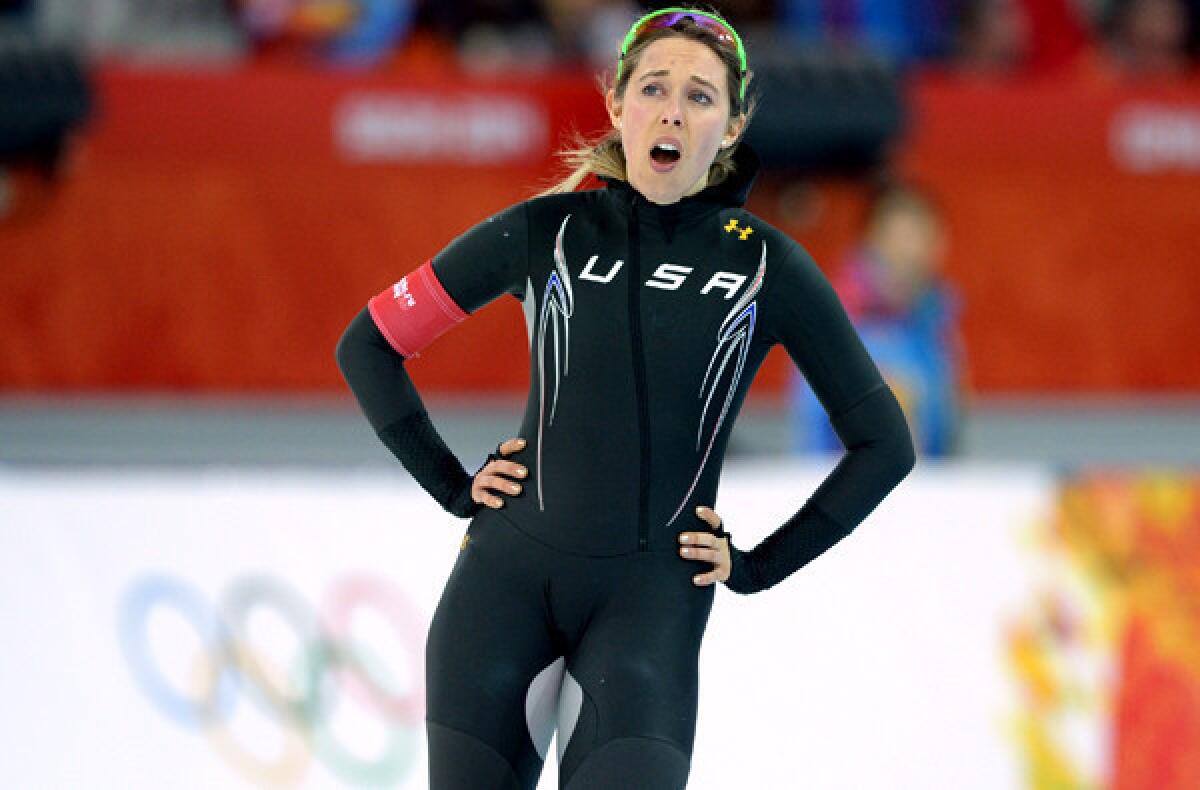In speedskating, there seems to be a wrong side of the tracks

- Share via
SOCHI, Russia -- It’s never easy being the youngest.
But what if you had to live up to the standards of your much older and established sibling and do it while sharing your room with someone you had little in common with? Then you might have a sense of what it is like to be short-track speedskating at the Olympics.
When short track begins Monday in only its seventh Games, it does so with a bit of second-class-citizen status to speedskating, the sport’s traditional discipline. To add to the insult, short track is held in the Iceberg Skating Palace, where the ice is tailored to the figure skaters it was built to showcase.
FRAMEWORK: View the best images from the Sochi Olympics
“It’s always been the little brother,” said Bryce Holbech, a consultant with the U.S. team.
Long-track speedskater Anna Ringsred started at 13. She has never competed in short track.
“I’m one of the few purists here,” Ringsred, 29, said. “I’ve never done anything else beside long track.”
Ringsred spoke playfully but “pure” is often used to describe the difference between the sports.
To the uninitiated watching the Olympics, the sports can be hard to distinguish.
Long-track speedskaters glide around on 400-meter ovals. They set off two at a time, racing against the clock, not necessarily the other skater. When the Winter Games began in 1924, speedskating was on the menu. In Sochi, long-track competition is taking place in a new arena of sparkling glass where stands have been nearly full in the first days of competition.
On the other hand, short-track competitors take off in groups within a 110-meter oval. They set off in packs, racing against each other and the clock. It got its Olympic start in 1992, four years after being staged as a demonstration sport in Calgary, Canada. Despite its growing popularity, buffeted by former U.S. star Apolo Ohno, its schedule is set around figure skating’s, competing before the more popular, TV-ratings behemoth takes the stage in prime time.
Long-track participants practice and compete on the same ice. Short-track athletes are sometimes forced to train next door to the Iceberg.
Long-track conditions are constant. Short-track ice can be soft and thick, as figure skaters prefer. Building technicians make adjustments to cool the ice four degrees to help short-track skaters. After Monday, short track and figure skating compete on different days except for one, when the ice must be transitioned in less than three hours.
“I don’t know how they’re going to do it but it will be interesting to see,” said Holbech.
The personalities between the long and short track are different too. Short-track skaters tend to be more whimsical and free spirited and long-track skaters tend to be focused on control.
“Long track is more of a symphony. ... You’re out there and you want to get in the zone,” said short-track skater Eddy Alvarez, 24, the first Cuban American male Winter Olympian. “Short track is like metal rock. You kind of always got to be on your toes. ... It’s more intense.”
Pat Meek began skating at 4. He gave up short track when he was 17, frustrated with skaters who responded to falls and disqualifications with a shrug, “Oh, that’s short track.”
“That phrase drove me nuts,” Meek said.
Short-track skaters do three events: 500, 1,000 and 1,500 meters. Long track is more specialized, meaning racers compete in only one of five distances in some cases. Some short-track skaters raced in nearly two dozen races at the U.S. trials.
Short track is, by every measure, more dangerous. Skaters race tightly bunched not unlike NASCAR, bumping into and weaving around each other for position, sometimes tumbling into the wall. Four skaters, including Ohno, collided and crashed in a 2002 final, allowing Steven Bradbury of Australia to sail to a gold medal.
Perhaps not surprisingly, Ohno, now broadcasting for NBC, said he finds short track more exciting to watch.
“These guys are whipping around this rink at like 30 miles per hour and they’re skating on a blade that’s one millimeter thick,” Ohno said.
Long track is dominated by the Netherlands, where the sport is followed like the NFL in the U.S. The Dutch have not won a short-track Olympic medal.
Short track is dominated by South Korea, China, Canada and the U.S., which have won 104 of 120 medals. All but eight of South Korea’s 45 medals in Winter Games have come from speedskating.
Short-track skater J.R. Celski, 23, who won two bronze medals in 2010, said he understands why the Olympics have two sports, “but at the same time, I wish we did have our own control over the ice,” where conditions were difficult in Vancouver in 2010.
Celski, the 500-meter world-record holder, came to the sport from inline skating without trying long track. He doesn’t buy the suggestion that long-track speedskating is more “pure.”
“I don’t know what they mean by that,” he said, laughing. “We’re pure, too — we come out here and skate.”
Twitter: @jaredshopkins
em>
Twitter: @jaredshopkins
More to Read
Go beyond the scoreboard
Get the latest on L.A.'s teams in the daily Sports Report newsletter.
You may occasionally receive promotional content from the Los Angeles Times.






